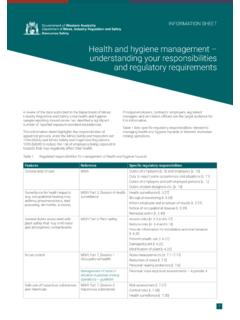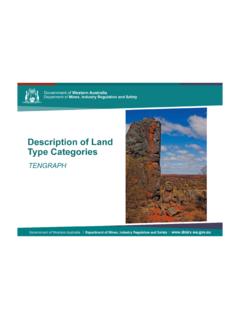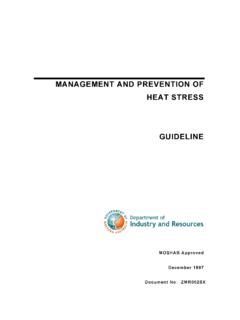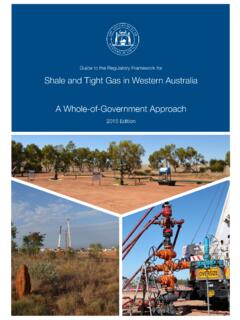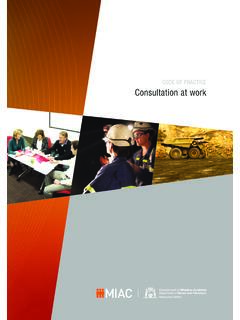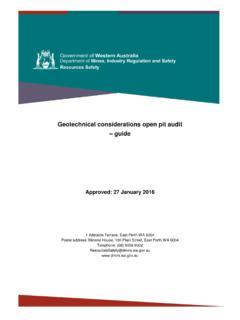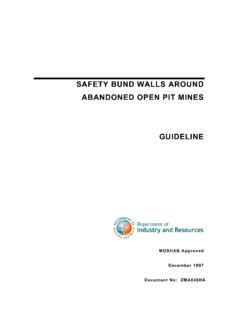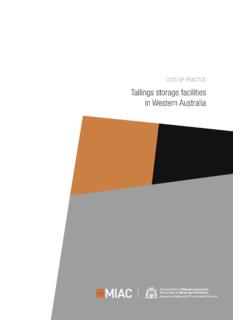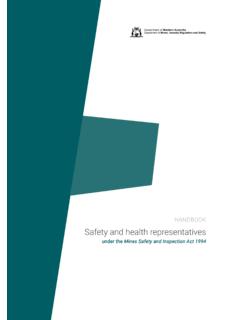Transcription of Management of diesel emissions in Western Australian ...
1 GUIDELINEM anagement of diesel emissions in Western Australian mining operationsDisclaimerThe information contained in this publication is provided in good faith and believed to be reliable and accurate at the time of publication. However, the information is provided on the basis that the reader will be solely responsible for assessing the information and its veracity and State shall in no way be liable, in negligence or howsoever, for any loss sustained or incurred by anyone relying on the information, even if such information is or turns out to be wrong, incomplete, out-of-date or this disclaimer:State means the State of Western Australia and includes every Minister, agent, agency, department, statutory body corporate and instrumentality thereof and each employee or agent of any of includes information, data, representations, advice, statements and opinions, expressly or implied set out in this includes loss, damage, liability, cost, expense, illness and injury (including death).
2 ReferenceThe recommended reference for this publication is: Department of Mines and Petroleum, 2013, Management of diesel emissions in Western Australian mining operations guideline: Resources Safety, Department of Mines and Petroleum, Western Australia, 37 978 1 92 2149 04 6 Department of Mines and Petroleum where the Copyright Act otherwise allows, reproduction in whole or part of this publication will be permitted only with the prior written permission of the Department of Mines and Petroleum. Applications for permission should be addressed to the Manager Safety Communications, Resources publication is available on request in other formats for people with special publication is also available in digital format (PDF) online at details of publications produced by Resources Safety can be obtained by contacting.
3 Resources Safety Publications Department of Mines and Petroleum 100 Plain Street EAST PERTH WA 6004 Telephone +61 8 9358 8002 (general queries) +61 8 9358 8154 (publication orders)NRS 13 36 77 Facsimile +61 8 9358 8000 Email (general queries) (publication orders)iiManagement of diesel emissions in Western Australian mining operations guidelineManagement of diesel emissions in Western Australian mining operations guidelineiiiiiiContentsForeword ..iv1 Introduction ..12 Management process ..43 Formation of DPM and other pollutants ..64 Exposure limits and health effects ..105 Monitoring diesel emissions ..126 Source controls.
4 147 Transmission controls (ventilation) ..208 Exposure controls ..229 Further information ..25 Appendix 1 Legislative provisions ..29 Appendix 2 Example checklists ..31 Appendix 3 Determining DPM as elemental carbon ..35 Management of diesel emissions in Western Australian mining operations guidelineForewordThis guideline is issued by Resources Safety under the Mines Safety and Inspection Act 1994, and has been endorsed by the Mining Industry Advisory Committee (MIAC).The ActThe Mines Safety and Inspection Act 1994 (the Act) sets objectives to promote and improve occupational safety and health standards within the minerals Act sets out broad duties, and is supported by regulations together with codes of practice and Mines Safety and Inspection Regulations 1995 (the regulations) provide more specific requirements for a range of activities.
5 Like the Act, the regulations are enforceable and breaches may result in prosecution, fines, or directions to cease operations and undertake remedial provisions of this guideline apply to all mines as defined in section 4(1) of the guideline is an explanatory document that provides more information on the requirements of legislation, details good practice, and may explain means of compliance with standards prescribed in the legislation. The government, unions or employer groups may issue guidance with guidelines is not mandatory but they could have legal standing if it were demonstrated that the guideline is the industry norm. Who should use this guideline?This guideline should be used by anyone planning or conducting underground mining where diesel engines are likely or are being used, particularly those persons responsible for the occupational health of of diesel emissions in Western Australian mining operations guideline11 Background informationThe use of diesel -powered plant in underground mining has steadily increased since the 1960s.
6 During this time, diesel -driven mechanised machinery has replaced physical labour or pneumatically driven machines. Today there is a mechanised diesel unit for many underground operation. As a result of the combustion process, diesel engines emit diesel particulate matter (DPM), exhaust gases, including a wide range of organic vapours, and a small amount of metallic compounds. For the purposes of this guideline, these components are collectively referred to as diesel emissions . diesel emissions pose both short- and long-term risks to health, ranging from mild effects, such as headaches, irritation and nausea, to respiratory disease and cancer. There is also the issue of chemical asphyxiation from carbon monoxide. Appendix 1 lists the legislative provisions that apply to the ventilation of underground mines in Western Australia and monitoring of airborne line with sound risk Management practices, the risks from diesel emissions should be assessed and controlled to an acceptable standard.
7 There is currently no national exposure standard for DPM. However, a number of regulatory agencies in Australia have adopted the Australian Institute of Occupational Hygienists (AIOH) exposure limit recommendation of mg/m3 as elemental carbon measured as a time-weighted average over eight hours (adjusted for extended workshifts). The AIOH recommendation was developed because of the irritant health effects from exposure to diesel emissions , with the view that compliance would reduce the risk of health effects. While there are no national regulations or standards in place that limit emissions from non-road diesel engines, Australia has benefited from the importation of engines compliant with United States (EPA Tier 1 to 4), European Union (Stage I to IV) and other emission standards, which has contributed to reduced emissions .
8 Industry data submitted to Resources Management of diesel emissions in Western Australian mining operations guideline2 Safety over the past few years indicate that it is reasonably practicable for underground mines to achieve compliance with the AIOH recommendation of mg/m3 for DPM. However, some sites have not effectively controlled emissions to maintain employee DPM exposure levels below mg/m3. Industry experience indicates that successful diesel emissions Management programs are those taking a holistic approach to deal with a broad range of risk factors. The best outcomes are achieved by addressing this hazard at the mine design stage and consulting the ventilation officer when planning mining operations. Successful strategies are those that eliminate or reduce: diesel engine emissions at their source the transmission of DPM through the underground environment personal exposure.
9 ScopeDiesel emissions are a particular problem in enclosed environments such as underground mines, workshops and train load-out tunnels where exhaust particulates and gases can accumulate if ventilation is inadequate. This guideline describes the nature and production of diesel emissions , the associated risks, and recommends ways to mitigate exposure. Chapters 6 to 8 introduce potential strategies to address issues associated with emission, transmission and exposure. While there are proven control strategies that can be implemented, such as diesel engine maintenance procedures, all measures should be considered to ensure diesel emission exposures are maintained as low as reasonably is imperative that implemented measures are maintained and monitored by mine Management .
10 Note: This guideline applies to all underground mines except those extracting of diesel emissions in Western Australian mining operations Classification of diesel emissions as a carcinogenIn 2012, the International Agency for Research on Cancer (IARC) classified diesel engine exhaust emissions as carcinogenic to humans (Group 1), based on sufficient evidence that exposure is associated with an increased risk for lung cancer. A positive association, with limited evidence, of an increased risk of bladder cancer was also IARC was careful to state that the classification of diesel emissions as a carcinogen was independent of determining the duration, frequency and concentration of exposure required to produce an actual risk. As with many exposures, the probability of harm increases with the level of exposure, and this was an important aspect of the IARC s findings.
